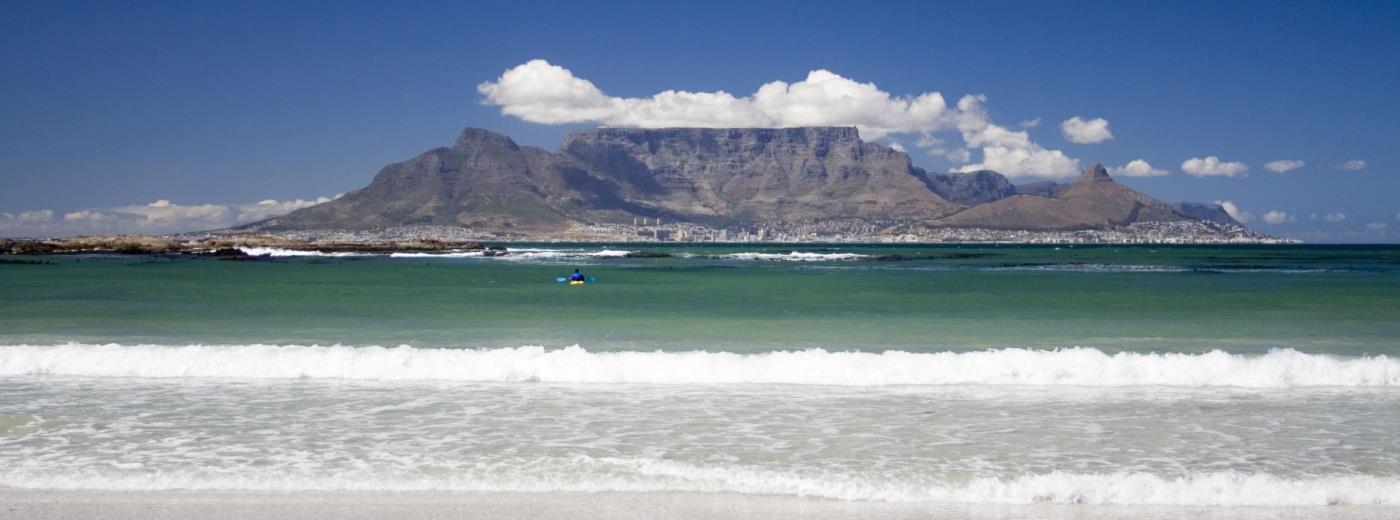Weather and Climate
South Africa is a great year-round destination, with plenty of reasons to visit at any time of year, although the climate of this vast country does vary greatly by region and by month.
Generally speaking the Western Cape area has a more Mediterranean style climate with hot, dry summers from November to March and cooler wetter winters from May to August. The areas around Port Elizabeth and the Eastern Cape Game reserves are similar to the Western Cape, although the winters are not quite as wet. As you head further north, the rain pattern changes and we find regions with hot, humid and occasionally very wet summers, and cooler drier winters - this pattern is particularly noticable around Kruger, Johannesburg and the game reserves of Madikwe, Pilanesberg, and the Waterberg.
Northern regions that are at higher altitudes such as Johannesburg or the Giants Castle area of the Drakensberg Mountrains will see quite large variations between average high and average low temperatures during the winter months, and it is not at all uncommon to find temperatures around freezing over-night and then warm enough for shorts and T-shirts in the middle of the day. This variation in temperature during the course of the day is also an issue for visitors to the games reserves where it can feel very chilly on early morning and later afternoon games drives but much warmer in the middle of the day.
The Western Cape
Around Cape Town, Hermanus, the Cape Winelands and the Garden Route, average daytime temperatures in the South African summer months are very pleasant, ranging between 14°C up to 26°C. On most days you will have 11 hours or more of sunshine, extending into warm evenings with the occasional rain shower. The summer south-easterly 'Cape Doctor' wind, however, can blow into an uncomfortable gale, especially near the coast.
In the winter months (June to August), average daily temperatures typically range between 8°C to 18°C, but the bracing sea breeze can make the temperature feel cooler and this is also the main rainy season. Temperatures along the Garden Route do not vary quite as much between summer and winter as we see closer to Cape Town, and the rains are also spread more evenly throughout the year with more summer showers and fewer winter storms.
Although the appeal of visiting these areas in the South African summer is fairly obvious, we would suggest that these areas are still worth considering even in the milder winter months. There is a huge amount to do in Cape Town that is not dependent on the weather, and the winter is when the whales come into the bay near Hermanus which is one of the world's best whale watching destinations. You would still expect to see a fair amount of sun in Cape Town even in winter, and average daily highs of 18°C are not really that cold. Finally, you will find that hotel rates tend to be a little lower in Cape Town during the winter, and visiting South Africa in the winter will also mean that you could visit the Kruger area during the best months for a safari there.
Cape Town Average Max and Min Temperature
Cape Town Average Rainfall (mm)
Knysna Average Max and Min Temperature
Knysna Average Rainfall (mm)
Port Elizabeth and The Eastern Cape Game Reserves
Port Elizabeth claims to have the best climate and more sunshine than any other coastal resort in the country, and average highs reach the mid-high 20s °C in the November to April summer months, and even in winter average daily highs remain around 20°C. The coastal setting also stops the evenings getting too cold there is only moderate rainfall throughout the year.
Further inland, the temperatures at the Eastern Cape Game Reserves are broadly similar to those in Port Elizabeth, however the daily highs are a little higher throughout the year, and the lows are a little lower in the winter months. The summer months of December to March are the hottest months, with temperatures average daily temeratures close to 30°C - but short thunderstorms in the late afternoon help to cool off the heat of the day. Autumn (April and May) is pleasant, with average daily highs of about 25°C, but the early mornings and evenings can be quite cool so you'll need to take a fleece or wear several layers on your morning and evening game drives.
During the winter months of June, July and August, temperatures can get down towards zero at night and in the early mornings, but during the day the average high still reaches the low 20s. In September and October, things start to warm up again, but the evenings are still cool until summer starts to get underway towards the end of the year.
Port Elizabeth Average Max and Min Temperature
Port Elizabeth Average Rainfall (mm)
Addo Average Max and Min Temperature
Addo Average Rainfall (mm)
Around Kruger National Park
The summer months in the Kruger National Park (November through to April) are extremely hot and humid. Average daily highs are around 32°C, and temperatures can soar over 40°C on occasion and this is also the rainy season. Many animals give birth when the first rains fall, so it is an excellent time to visit if you want to see lion cubs at play or wobbly antelope calves following closely behind their mothers.
The winter months are substantially cooler and drier, and generally better for game viewing. The bush dries back, making it easier to spot game, plus the animals are more dependent on the waterholes and permanent rivers, so game viewing is particularly good around these areas.
Visitors in the winter months should be especially aware of the variation in temperarture during the day when on safari - morning game drives will feel very chilly on the back of the moving safari vehicle until the sun has been up for a little while, and when the sun sets again in the evening the temperatures drop very quickly making the last part of the afternoon/evening game drive very chilly. You will want to have a jacket or fleece and dress in layers so you can easily adust for the changing temperature whilst on game drives.
Kruger Park Average Max and Min Temperature
Kruger Park Average Rainfall (mm)
Johannesburg, Sun City And The Waterberg
Johannesburg has a pleasant all year round mild climate. Partly due to its elevation of over 1,750m above sea level, Johannesburg is fortunate to have warm summer days and pleasant summer evenings, with average highs around 25°C. Although these months are also the rainy season, the weather rarely feels too humid. In the dry winter months, the daily high temperatures are around 16 to 20°C with crisp, clear nights and frosts are not uncommon.
The main attactions a couple of hours drive from Johannesberg include The Waterberg Safari Reserves to the North East and Sun City and the Pilanesberg National Park which neighbour each other to the North West.
Summer (November to end of March) is the rainy season in both the Waterberg and Sun City /Pilannesburg areas, with the highest rainfall accompanied with spectacular thunder and lightening shows. Daytime temperatures are hot and humid with an average high temperatures around 30°C.
The months of April to September are drier, with bright, clear and warm days and cooler evenings. The mid-winter months of May through to the end of August are the driest months, but early mornings and nights can get particularly cold, with average temperatures as low as 2 or 3 degrees C and ground frosts are common.
Johannesburg Average Max and Min Temperature
Johannesburg Average Rainfall (mm)
Sun City / Pilanesburg Average Max and Min Temperature
Sun City / Pilanesburg Average Rainfall (mm)
The Waterberg Average Max and Min Temperature
The Waterberg Average Rainfall (mm)
Madikwe Game Reserve
Spring (September to November) is when the bush in the Madikwe Game Reserve is at it's driest after the long dry winter, and with average tempereature ranging from lows aound 12°C to highs above 30°C this is an excellent time of year to visit the reserve. In October there may be thunderstorms, and by November the chance of afternoon showers becomes greater, which means the bush begins to turn green.
The summer months (December to March) are hot, and days are often interrupted by spectacular afternoon thunderstorms that are as brief as they are intense. During December and January many of the antelope species give birth to their young, and the bush is now many shades of green. January and February are the hottest months of the year, but towards the end of March the heat is less intense and the chance of rain lessens.
In autumn (April to May) the bush begins to get dryer, the vegetation becoming less dense and the grasses begin turning brown under the sun. The temperatures start dropping at night but the daytime is still warm with highs in the mid-high 20s. Scattered thunderstorms are still occasionally experienced in the afternoon.
June, July and August are the mid-winter months, and are the coolest and driest time of the year, with average lows below 5°C and some nights where the temperatures will drop below freezing. The sun will still warm temperatures to average highs of around 22°C, and as the lack of rain means the bush is drying out all the time and animals are more reliant on waterholes making them a little easier to find.
Madikwe Average Max and Min Temperature
Madikwe Average Rainfall (mm)
Durban And KwaZulu-Natal
Durban and the surrounding coastal areas have a sub-tropical climate with hot humid summers running from November to March, and cooler drier winters with June to August being the coolest and driest months.
The far north of the KwaZulu-Natal coastline towards the Mozambique border has similar weather pattern to the Durban coastal areas, although temperatures tend to be a few degrees higher.
The way to escape the coastal heat during the height of summer is to head to the stunning Drakensberg Mountains, where temperatures at, for example, the Giant's Castle area are always few degrees cooler than at the coast (average highs 22-23°C during the Summer, but only 14-15°C in winter). The Drakensberg has an even more marked summer-rain profile than the coast, with heavy rains falling between November and March, and in mid-winter (June and July) average low temperatures fall below freezing.
The game reserves and National Parks of KwaZulu-Natal have a subtropical climate with hot, humid, wet summers (September to April) and warm to cool, dry winters (May to August). Daytime summer temperatures may rise above 35°C although the average is around 27°C, and winter nights rarely drop below 10°C. Rainfall occurs predominantly in the summer months from September to April in the form of magnificent late afternoon/evening thundershowers.


